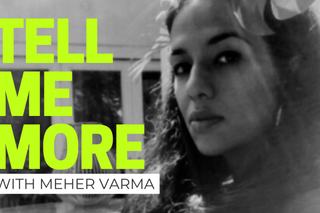
Tell Me More: Talking Inequality in Sustainable Fashion Aesthetics With Meher Varma
“Do people even know what ‘sustainability’ translates to in Hindi, or any other regional language?”

In The Swaddle’s interview series Tell Me More, we discuss crucial cultural topics with people whose work pushes societal boundaries.
Meher Varma is a cultural anthropologist, strategist, and writer. The Swaddle’s Aditi Murti spoke to Meher about sustainable fashion aesthetics, moral posturing in fashion, and the role of caste in how we see designers versus karigars (craftsmen).
The Swaddle: When you talk about the difference between sustainable fashion aesthetics and mainstream Indian fashion aesthetics (think: bridal couture), there’s a radical difference, because the former is a lot more monastic and feels like an outright rejection of the latter. So, what is the need to so obviously distance yourself from the bling?
Meher Varma: At the turn of the millennium, there was this celebration of surface ornamentation, and that is what really dictated value. If you went into an Emporio Mall (Delhi) or you went into a couture shop, you could actually see the shelves and the store organized according to value. Visibly, that value corresponds to surface embroidery. So, the lighter garments with less embroidery would always be in a certain place, and then as you worked deeper and deeper into the designer store, particularly a couture store, the garments got heavier and heavier and so did the prices. The idea was that the more kaam (surface embroidery) there was, the better the garment was. And kaam, is visible as well as tactile. It connotes the amount of labor that’s been put into a garment. Up until about 10 years ago, a bride really needed to wear kaam or craftsman’s labor on her sleeves to mark herself as worthy.
But, as you said, there’s been a rethinking of that, and this happened for several reasons. First, couture is now accessible to a class that didn’t have it previously — this is often a class condescendingly called ‘new money’ by those who want to distance themselves from the rural elite, or those who made their fortunes after liberalization. Just as kaam became easier to acquire, the lack of kaam became associated with something deeper, like conceptual design and historic textile. Simplicity became the aesthetic of embarrassed wealth.
TS: Apart from the distancing, why would simplicity appeal to somebody who considers themselves more ‘old money’?
MV: I think it’s the difference between cultural and economic capital. You know, there’s always a link we make between class, sophistication, and subtlety. Cultural capital is not about things that are immediately visible. So for example, an excellent education, a good suntan, your appetite, your taste — these are things that all convey class, but it’s not like that person has to necessarily drive around in a Porsche.
I think that this gravitation towards not having to display surface embroidery or to show exactly what’s gone into the garment is naturally more appealing to people who express class through more subtle — more ‘hard to acquire’ means. ‘Simplicity’ is a stand-in for cultural capital.
TS: There’s also this recurring phenomenon of reiterating the importance of a craftsman throughout Indian fashion in order to drive in the idea of ‘high value’ garments or brands. What influences this phenomenon?
MV: There’s this euphemism, we often hear, especially with respect to how consumers experience Indian clothes — it’s in the phrase ‘good finish.’ A garment can be beautiful and aesthetically trendy, et cetera. But a client might say like, the finish is not good, and the garment is immediately rejected. This is a phrase that is really loaded for me because it signifies something about class. So usually what happens when a finish is ‘good’ is that the designer has created the design, a highly-skilled craftsman has worked overtime probably to produce that design, and then it’s gone back to the designer to finish it. That final touch has to be from someone who is upper caste — that’s what it means to have clothing with a ‘good finish.’ The craftsman’s hand and the designer’s hand could be exactly the same in terms of talent, but the client is actually looking for an upper-caste hand to package the product while still relying mostly on the craftsman’s labor. It’s not particularly relegated to Indian clothes — someone who makes linen dresses can also have a similar attitude.
TS: This focus on craftsmen is particularly magnified when it comes to sustainable fashion brands because they want to put their ethical process and payment ethos upfront. Is the craftsman aware of the value he brings to such branding?
MV: One of the ways in which we really show that the power dynamic has not quite shifted is by imposing our idea of value on those who have not always enjoyed privilege. There’s this anecdote: one of my friends was working on a collection, which she had very good intentions for — still does. She wanted it to be an ethical collection and she was working with the craftsmen very closely. Of course, the key difference was that they were the ones who actually had the talent. She was kind of the apprentice, but she was the designer.
So, she had thought quite hard about how to make this a fair, ethical collection. She decided that all of the craftsman’s initials should be embroidered on the garments. When she told them, they turned around and they said that we don’t want this kind of credit. And that I think was a really important moment because what they meant is — that’s the designer’s idea of ethics, but what the craftsmen would have preferred was maybe more money and a few more days off. But what happened instead, was as usual, a universal (i.e., western) idea of ethics was applied to people who don’t experience fairness in the same ways.
Related on The Swaddle:
Women Bear the Brunt of Bangladesh Garment Industry’s Covid19 Layoffs
TS: I’d assume a designer who leans towards sustainability possesses enormous cultural capital, which is probably why we also see them champion certain causes or blend certain facets of activism like feminism into their brand identity. Does intention meet behavior and action often?
MV: You know, it’s really hard to tell now because the aesthetic that signals sustainable fashion has become mainstream. So there’s no longer a link between the creator and wearer of sustainable clothing and how moral or ethical they are. You could be a gangster and also be making minimal linen dresses. You could kill a person in a white linen khadi dress.
But I do believe that there are lots of sincere designers committed to sustainability and ethics that align with the craftsmen they work with. But it’s definitely a fight to keep that alive alongside the amount of greenwashing that is gaining momentum. Plus, the number of people picking up on the idea that ethics can be commodified, packaged, and sold is dangerous, because it’s also true.
Beyond greenwashing, there are also forms of tokenization. If you talk to queer designers or queer people in the industry, they often feel tokenized. Suddenly, a designer will feel compelled to do an LGBT collection or add one queer model to his/her show. There also has to be one plus-size model — all of this is not usually about acceptance, it’s an opportunity for the designer to show his/her ethics.
TS: Coming to more feminist aspects of sustainable fashion, I’m fascinated by anti-fit clothing, because it’s such a unique stand against the male gaze, but still exclusionary, because it’s designed to flatter mostly thin bodies. Does this betray a convenience of feminism, or is that a cynical outlook?
MV: I think the practicality of the anti-fit dress is valuable. This clothing is comfortable, it has breathable fabric, and makes logical sense to wear — especially in Indian weather. I also do share a degree of cynicism with you: despite how it’s marketed, this doesn’t indicate feminism to me. Are women more empowered because they get to float around in big, shapeless things? Not at all, because the body and the required standards of beauty are still the same.
Who actually looks good in this anti-fit outfit, right? It’s the body that the patriarchal gaze likes. Whether they’re in a tight, Hervé Léger size two dress or a huge chola dress, the body and the work that that body requires are still the same. In fact, it’s harder to look good in a baggy chola dress than it is in the Hervé Léger because the beauty — the standards of beauty that are required are encrypted. And I’m using the word encrypted on purpose because it is something that is almost punishingly difficult to achieve. You might be floating around in a blanket-sized dress, but, the things that are then signaled and paid attention to are things like the quality of your skin, the quality of your teeth, the quality of your nails, the glow of your skin. In a baggy dress, that takes even more work to showcase. So that patriarchal gaze maybe even gains more power within this trend.
Related on The Swaddle:
Decoding the ‘Fat Tax’: Why the Indian Fashion Industry Charges More for Bigger Clothes
TS: With respect to using morality as branding, fast fashion has been able to easily borrow and appropriate a lot of the ethics of slow fashion. Why do you think that is?
MV: It’s pretty clear that there’s no longer a divide between fast fashion and the idea of sustainable fashion. Zara has a sustainable collection. You could set up a factory and make 50,000 khadi dresses and call it sustainable, but I’m yet to see a sustainable fashion practice that’s large scale and ethical. When I mean truly ethical, I mean actually splitting our profits with the craftsmen, actually empowering them, and taking their idea of fairness, and long term skilling into account. If you do get an order for 100,000 things, you’re asking the craftsman to produce the same design that many times. They’re not learning anything else during that enormous amount of time — this leads to de-skilling, a lack of evolution and trajectory.
TS: How involved are Indian craftsmen with ideas of sustainability? Is it hard for designers to engage them due to their own know-how with respect to this universally accepted idea of sustainable design vs. India-specific ideas?
MV: Speaking very generally, I’ve been to factories where I’ve been behind-the-scenes, I’ve never heard anyone except a designer, or an assistant designer, or someone at that admin-level use the word ‘sustainable,’ and that’s quite telling. Do people even know what ‘sustainability’ translates to in Hindi, or any other regional language?
In India, there’s a unique and powerful history of sustainability — we have traditional upcycling for instance. It would be wonderful if rafoo (darning) became the hip word, rather than ‘sustainable.’
TS: Do you think the sustainable fashion market can do any material good, or is it just another consumer market?
MV: I think the best thing we can do is limit consumption — buy less. I don’t think that creating some pineapple or banana fiber and then producing it like fast fashion is going to do anything. Because, then, at the scale that our desire works, we’ll just run out of bananas and pineapples. Less desire for the material, more desire for the intangible: well, that would be the seed of a revolution.
Aditi Murti is a culture writer at The Swaddle. Previously, she worked as a freelance journalist focused on gender and cities. Find her on social media @aditimurti.
Related


Pakistan’s Entertainment Industry Is Finally Confronting Its Sexual Harassment Problem
